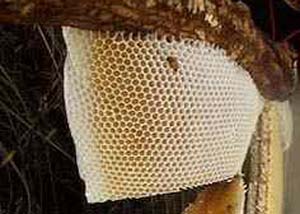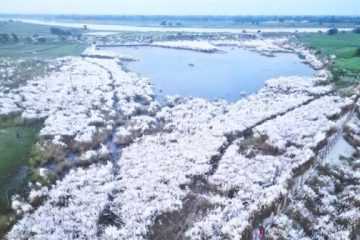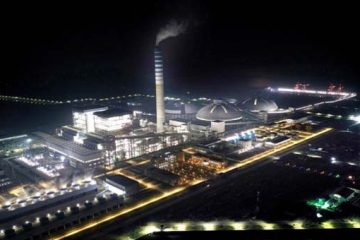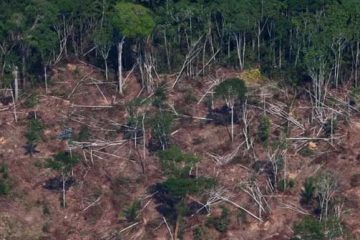Dr. M.A. Bashar for The Independent
 In Sundarbans ecosystem, honey and wax production is a major seasonal activity employing some 2000 honey collectors known as ‘mowallis’ and producing about 200 tonnes of honey and about 50 tonnes of bee wax which constitutes about 50 per cent of the total production in Bangladesh. So far information is concerned, it is to be noted that no country in the world has got even 50 percent of its national honey production coming from natural system. Apiculture or colonisation of bees made by men provides the honey production in other countries of world. But only Bangladesh has got the natural privilege and mangrove ecosystem’s gift in different status.
In Sundarbans ecosystem, honey and wax production is a major seasonal activity employing some 2000 honey collectors known as ‘mowallis’ and producing about 200 tonnes of honey and about 50 tonnes of bee wax which constitutes about 50 per cent of the total production in Bangladesh. So far information is concerned, it is to be noted that no country in the world has got even 50 percent of its national honey production coming from natural system. Apiculture or colonisation of bees made by men provides the honey production in other countries of world. But only Bangladesh has got the natural privilege and mangrove ecosystem’s gift in different status.
It is to be remembered that biodiversity is comprised of three components like species diversity, genetic diversity and ecosystem diversity. The first two components (species and genetic diversity) interact each with other. This means that interrelationships between biotic and biotic factors enhance and establish these relations (the interaction in between the genetic and species diversity) in nature. This interaction in connection with the ecosystem diversity makes a structural formation of the biodiversity. And that is why healthiness of biodiversity in an area maintains environmental balance in the natural system. The biodiversity depletion starts at the atomic level first that means in the initiation of interactive level between biotic-biotic relation among the plants and animals in an area of out plane. Mainly this happens when gene-flow activities are dependent on the relations between an insect and its related plants. This type of model interaction is mostly exemplified in the relation between honey bees and the related plants, particularly in an ecosystem like sundarbans mangrove forest areas.
In the sundarbans mangrove ecosystem, it is found that about 35 wild and forest plant species are related with honey bees’ activities and rather to say with so called “apiculture” in sundarbans and so called “honey-collection”. Out of the 35 plant species, 7 or 8 plants and their reproductive stage (flowering stages) are deeply associated (functionally related) with the honey production periodicity (the seasonality of honey collection), forest –plant gene-flow functionality, sustenance of forest healthiness, maintenance of general equilibrium position (GEP) of bee population in the forest, maintenance of bee progeny system (in natural system) and finally the maintenance of bee-caste system. These facts are externalities of the interactions depend on the synchronisation of coincidences between the phonological stages of the related plants and the life stages of the (specially the caste system) of the honey bees. This coincidence happens during the time-period of the reproductive stages of the related plants. It needs to be examined what is going on in the Sundarbans mangrove ecosystem regarding the question of reproductive (flowering) stages of the plants and the normal activities of the bees in the ecosystem. How gene-flow in the plant population and the healthiness (or unhealthiness) of the forest status are hampered which causes depletion of biodiversity as a whole. In this regard the interesting matter is the dynamism of the fact that starts at the atomic levels and expressed in the community levels.
In the Sundarbans, the deeply related plants with the so called ‘honey-collection’ by ‘mawallis’ during the time period of April to June in the year are very much important regarding the appearance of flowers in them. These plants are Khulshi (Aegiceras cornuculatum), baen (Avicennia officinalis), Kankra (Brugguiera gymnorrhiza) goran (Ceriops decandra), gewas (Excoecaria agallocha), Jhana/garzon (Rhizophora mucronata), Keora (Sonneratia apetala and S. acida), passur (Xylocarpus mekongenesis) and hargoza (Acanthus ilicifolius). In addition to that many other plants are also related but their flowering periods are not so synchronisingly associated with the temporal facts of time and honey collection in the ecosystem. Of the major plants khulshi flowering period continues for the period of March-April; baen flowers remain functional for the period of May to June; kankra gives lower during the month of April; goran flowering continues from the month of April to the end of May; jhana/garzan is provided with appearance flowers for the period of March and April; Keora species gives flower at the end of April and continues up to the end of May; passur flowering lasts for the during the months of March and April; and hargoza maintains flowering for the duration of the months of May and June. In the plant kingdom (especially for the case of flowering plants), flowering period is the most vital time for gene-flow successfulness, for population maintenance, for fruitification successfulness, and for healthiness of the ecosystem where they are living or/and propagating their generations. These functionalities in the plants are dependent (especially in the forest ecosystem) on the animals’s life cycle and are associated with synchronisation of coincidences between the ‘flowering’ of the plants and the ‘life stages’ of the animals concerned, especially with bees in majority cases. What marvellous fact of nature’s playing is prevailing in the sundarbans ecosystem has to be dealt with.
Very recently about nine weeks early it appeared in the dailies that, honey collection season in the Sundarbans has been launched through holding different programmers in 2011. A workshop was organised to mark the launching of the season on April 1. Presided over by an official of the forest department the workshop discussed measures on the honey collection and ‘mawallis’ protection. Delegates from other different countries also took part in the workshop. This year the ‘mawallis’ entered the forest on April 3. Generally, mawallis group is composed of 7-9 persons during the honey collection season. Mawallis name their groups after nine known mangrove trees, namely Sundari, pashur, Khalisha, goran, goalgach, bain, kankra, keora, and dalchaka. It has been known that this year the honey collection in the Sundarbans would last till June 15. According to the forest officials 54 permits have been issued on April 1 for honey collection. This is the tradition what is going on in the Sundarbans mangrove ecosystem since long time and the forest is always declining its status tremendously. On the other hand, hundreds of projects have been undertaken and many are still in practice to protect the Sundarbans ecosystem. No one is coming into being for the proper protection of the forest, the largest mangrove ecosystem in the world. Question is that whether we consider the facts like honey collection seasonality and other happenings in the forest scientifically viable/applicable or not? Whether these are functionally beneficial or harmful for the mangrove ecosystem’s healthiness and sustenance in the micro-level means at the molecular level?
In the traditional system of honey collection, it is clearly reported by the forest department that, the honey from Sundarbans is collected for a period of two months of the year commencing usually in April. The honey collectors have to collect the honey during the daylight hours and as such are subject to strong colony defence. Honey collectors are also the victims of many other unusual situations like tiger attacks. In combination of all these, the techniques of collecting honey are very faulty and rudimentary for the honey collectors. But for the honey bees the techniques are brutal and for the forest and mangrove ecosystem the techniques are devastating both in the micro-level and also in the macro-level (for plants’ gene-flow and plant population sustenance). All colonies that are encountered by the mawallis are harvested whether the honey is ripe or not and colonies are often destroyed brutally during the collecting process. Collection of wild honey from the wild honey bees is unique process in the world from the colonies of ‘Apis dorsata.’ ‘Apis dorsata’ build a single large and unique comb in an open place on the branches of a large tree. This type of comb preparation and honey building process is highly coincidental between the appearance of reproductive stage (flowering period) of some plants species (as stated above) and the progeny maintenance capacity materialisation stage of the honey bee (the Apis dorsata). This system is the naturally sustained unique process responsible for maintaining the large mangrove forest ecosystem in the world. The natural sustain system is being practiced naturally for the mechanisation of plant gene-flow. The gene-flow mechanisation is carried out by bees as the pollens of the mentioned plants are entomophilous means the pollination of the plants is happened by the insects and mainly by the wild bees. It is to be seriously considered that the major plants those responsible for providing nectars for preparing honey by the bees are at with flowering stage during the months of April to June. On the other hand, the wild bees are dependent of the pollens and nectars for the maintenance of their progeny and the strong wilderness. This type of unique forest ecosystem is the proper natural process for maintenance of the forest’s healthiness. If the honey collection takes place in the immature stage of the honey comb and the maintenance of caste system in honey bees is destroyed so brutally, the healthiness of the plants in the forest definitely stands vulnerable because the floral reproductive activities are remained under unusual passage. Obviously the plants in the forest will be at risk of having attacked by various diseases easily. Ultimately forest status will have to be threatened and declined continuously.
Very recently the UN officials expressed alarm at a huge decline in the bee colonies under multiple constraints. International efforts have been urged to save the pollinators that are vital both for cultivated and wild plants. The UN environmental agency has pointed out that including all other causes the loss of flowering plants stands very vital reason of the bee population decline. The UNEP executive said that “The way humanity manages or mismanages its nature-based assets, including pollinators, will in part define our collective future in the 21st century”. In spite of the wild plant populations, “The fact is that of the 100 crop species that provide 90 per cent of the world’s food, over 70 are pollinated by the bees”. Honey bee colony declines in the recent years reached up to 85 per cent in some areas of the world, and that is very alarming. This is an over all situation of the world, but the situation in the Sundarbans ecosystem is rather more dangerous as because not only the question of honey production and bee population is concerned, but the whole ecosystem is interlocked with the fact of gene-flow in plant kingdom and the status of successive trophic levels (animal populations and their status) in the forest ecology.
Improper and unscientific collection of honey in the Sundarbans causes desynchronisation of coincidences between reproductive stages of major plants (those that give flower in the period of March to June) and the vital life stages of the honey bees (the key agent for maintaining ‘general equilibrium position–GEP’ in the plant population). The question is that maintenance of the bee population’s GEP is the natural security of the sustenance of reproductive stages of the forest plants. If the plant population is hampered, there will be a big gap in the synchronisation of trophic supply to the all animals living in the forest. Because presence of high species composition in an ecosystem is interacted with abiotic factors over there and the combined situation makes there a suitable environmental conditions for sustenance of animal population. This situation provides the best habitat for biodiversity as a whole. It is to be noted that the large animals are very poor to maintain the secret activities and functioning of the forest ecosystem at atomic and molecular levels but the smaller animals like insects. These smaller insects must not be touched and must not be denormalised. Their life stages synchronisation is very much related with the protection of the plant population in the ecosystem at molecular level. If once the synchronisation is broken up, the entire ecosystem will stand scattered and unstable. Consequences will be must for the question of biodiversity loss what is the main situation prevailing in the Sundarbans mangrove ecosystem for the cause of improper and immature honey collection in the largest mangrove forest in the world.
Image: cellbazaar.com
Dr. M.A. Bashar, Professor, department of zoology and Ex-Dean, Faculty of Biological Sciences, University of Dhaka





